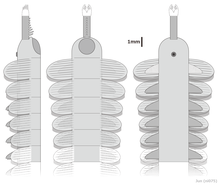
Castle Bank is a fossil deposit in Wales that is 462 million years old and dates from the middle Ordovician period when Mid Wales was covered by an ocean basin. [1]

Castle Bank is a fossil deposit in Wales that is 462 million years old and dates from the middle Ordovician period when Mid Wales was covered by an ocean basin. [1]
When 2020 COVID-19 lockdowns prevented Llandrindod residents and researchers for Amgueddfa Cymru – Museum Wales, Joe Botting and Lucy Muir, from travelling, they reinvestigated a site they had discovered a decade earlier in a nearby sheep field. They had failed to find the site interesting at the time because it was just a 10-meter-wide quarry. [2] [3] More careful examination has revealed an exceptional find among fossils. So far, 170 species have been found, among them more than 30 panarthropods and what resembles a marine relative of insects.
Being from the middle Ordovician, the fossils coincide with the Great Ordovician Biodiversification Event. What makes these fossils differerent from those found in places such as the Cambrian fossils of the Burgess Shale is their small size. Many forms that have been found in the Castle Bank deposit are of animals who had gone through a miniaturization trend when compared to Cambrian animals found among the Burgess Shale fossils, making the biota in the Castle Bank deposit more similar to modern faunas.
Their reduced size makes it difficult to identify some of the species, as most of these fossils are just between 1 and 5 mm in body size. Nonetheless, the fossils are exceptionally well preserved, with details as small as 10 μm often being visible, including tiny limbs, digestive systems, nerves, and filter-feeding tentacles. Such details also exist among certain Cambrian fossils, but have been absent from Ordovician finds that have been discovered to date. [4] [5] [6] [7]

The Burgess Shale is a fossil-bearing deposit exposed in the Canadian Rockies of British Columbia, Canada. It is famous for the exceptional preservation of the soft parts of its fossils. At 508 million years old, it is one of the earliest fossil beds containing soft-part imprints.

Ottoia is a stem-group archaeopriapulid worm known from Cambrian fossils. Although priapulid-like worms from various Cambrian deposits are often referred to Ottoia on spurious grounds, the only clear Ottoia macrofossils come from the Burgess Shale of British Columbia, which was deposited 508 million years ago. Microfossils extend the record of Ottoia throughout the Western Canada Sedimentary Basin, from the mid- to late- Cambrian. A few fossil finds are also known from China.

The Cambrian–Ordovician extinction event, also known as the Cambrian-Ordovician boundary event, occurred approximately 485 million years ago (mya). This early Phanerozoic Eon extinction event eliminated many brachiopods and conodonts, and severely reduced the number of trilobite species.
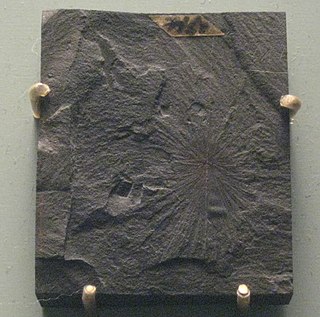
Choia is a genus of extinct demosponge ranging from the Cambrian until the Lower Ordovician periods. Fossils of Choia have been found in the Burgess Shale in British Columbia; the Maotianshan shales of China; the Wheeler Shale in Utah; and the Lower Ordovician Fezouata formation. It was first described in 1920 by Charles Doolittle Walcott.
The Burgess Shale of British Columbia is famous for its exceptional preservation of mid-Cambrian organisms. Around 69 other sites have been discovered of a similar age, with soft tissues preserved in a similar, though not identical, fashion. Additional sites with a similar form of preservation are known from the Ediacaran and Ordovician periods.

Marrellomorpha are an extinct group of arthropods known from the Cambrian to the Early Devonian. They lacked mineralised hard parts, so are only known from areas of exceptional preservation, limiting their fossil distribution. The best known member is Marrella, with thousands of specimens found in the Cambrian aged Burgess Shale of Canada. The group is divided up into two major orders, Marrellida and Acercostraca. Marrellida is recognised by the possession of head shields with two or three pairs of elongate spine-like projections, and three pairs of uniramous appendages on the cephalon, while Acercostraca generally have large ovoid carapaces that cover the entire upper half of the body, and five pairs of uniramous cephalic appendages. Both groups have unbranched antennules and a segmented trunk with biramous appendages. Recent research has suggested the previously enigmatic Cambrian trliobite-like arthropods Skania and Primicaris belong to this group. Their phylogenetic position is uncertain, various studies have alternatively placed them within in the Arachnomorpha as relatives of Artiopoda, as related to Mandibulata, or as stem group euarthropods.
The fossils of the Burgess Shale, like the Burgess Shale itself, are fossils that formed around 505 million years ago in the mid-Cambrian period. They were discovered in Canada in 1886, and Charles Doolittle Walcott collected over 65,000 specimens in a series of field trips up to the alpine site from 1909 to 1924. After a period of neglect from the 1930s to the early 1960s, new excavations and re-examinations of Walcott's collection continue to reveal new species, and statistical analysis suggests that additional discoveries will continue for the foreseeable future. Stephen Jay Gould's book Wonderful Life describes the history of discovery up to the early 1980s, although his analysis of the implications for evolution has been contested.
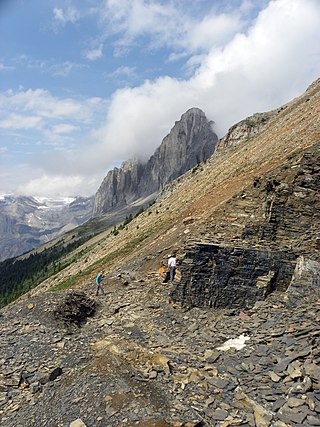
The Stephen Formation is a geologic formation exposed in the Canadian Rockies of British Columbia and Alberta, on the western edge of the Western Canada Sedimentary Basin. It consists of shale, thin-bedded limestone, and siltstone that was deposited during Middle Cambrian time. It is famous for the exceptional preservation of soft-bodied fossils: the Burgess Shale biota. The formation overlies the Cathedral escarpment, a submarine cliff; consequently it is divided into two quite separate parts, the 'thin' sequence deposited in the shallower waters atop the escarpment, and the 'thick' sequence deposited in the deeper waters beyond the cliff. Because the 'thick' Stephen Formation represents a distinct lithofacies, some authors suggest it warrants its own name, and dub it the Burgess Shale Formation. The stratigraphy of the Thin Stephen Formation has not been subject to extensive study, so except where explicitly mentioned this article applies mainly to the Thick Stephen Formation.

The Burgess Shale, a series of fossil beds in the Canadian Rockies, was first noticed in 1886 by Richard McConnell of the Geological Survey of Canada (GSC). His and subsequent finds, all from the Mount Stephen area, came to the attention of palaeontologist Charles Doolittle Walcott, who in 1907 found time to reconnoitre the area. He opened a quarry in 1910 and in a series of field trips brought back 65,000 specimens, which he identified as Middle Cambrian in age. Due to the quantity of fossils and the pressures of his other duties at the Smithsonian Institution, Walcott was only able to publish a series of "preliminary" papers, in which he classified the fossils within taxa that were already established. In a series of visits beginning in 1924, Harvard University professor Percy Raymond collected further fossils from Walcott's quarry and higher up on Fossil Ridge, where slightly different fossils were preserved.
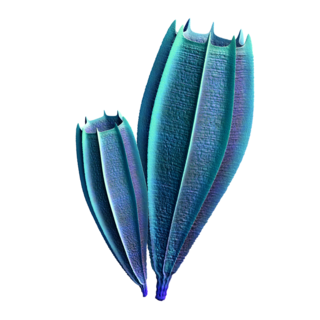
Takakkawia is a genus of sponge in the order Protomonaxonida and the family Takakkawiidae. It is known from the Middle Cambrian Burgess Shale that reached around 4 cm in height. Its structure comprises four columns of multi-rayed, organic spicules that align to form flanges. The spicules form blade-like structures, ornamented with concentric rings.
Eiffelia is an extinct genus of sponges known from the Middle Cambrian Burgess Shale as well as several Early Cambrian small shelly fossil deposits. It is named after Eiffel Peak, which was itself named after the Eiffel Tower. It was first described in 1920 by Charles Doolittle Walcott. It belongs in the Hexactinellid stem group. 60 specimens of Eiffelia are known from the Greater Phyllopod bed, where they comprise 0.11% of the community.
Hamptonia is an extinct genus of sea sponge known from the Middle Cambrian Burgess Shale and the Lower Ordovician Fezouata formation. It was first described in 1920 by Charles Doolittle Walcott. 48 specimens of Hamptonia are known from the Greater Phyllopod bed, where they comprise < 0.1% of the community.

Pirania is an extinct genus of sea sponge known from the Middle Cambrian Burgess Shale and the Ordovician Fezouata formation. It is named after Mount St. Piran, a mountain situated in the Bow River Valley in Banff National Park, Alberta. It was first described in 1920 by Charles Doolittle Walcott. 198 specimens of Pirania are known from the Greater Phyllopod bed, where they comprise 0.38% of the community.
Protospongia is a genus of Porifera known from the Middle Cambrian Burgess Shale. 102 specimens of Protospongia are known from the Greater Phyllopod bed, where they comprise 0.19% of the community.

The Fezouata Formation or Fezouata Shale is a geological formation in Morocco which dates to the Early Ordovician. It was deposited in a marine environment, and is known for its exceptionally preserved fossils, filling an important preservational window beyond the earlier and more common Cambrian Burgess shale-type deposits.

Opabiniidae is an extinct family of marine stem-arthropods. Its type and best-known genus is Opabinia. It also contains Utaurora. Opabiniids closely resemble radiodonts, but their frontal appendages were basally fused into a proboscis. Opabiniids also distinguishable from radiodonts by setal blades covering at least part of the body flaps and serrated caudal rami.

Aegirocassis is an extinct genus of giant radiodont arthropod belonging to the family Hurdiidae that lived 480 million years ago during the early Ordovician in the Fezouata Formation of Morocco. It is known by a single species, Aegirocassis benmoulai. Van Roy initiated scientific study of the fossil, the earliest known of a "giant" filter-feeder discovered to date. Aegirocassis is considered to have evolved from early predatory radiodonts. This animal is characterized by its long, forward facing head sclerite, and the endites on its frontal appendages that bore copious amounts of baleen-like auxiliary spines. This animal evolving filter-feeding traits was most likely a result of the Great Ordovician Biodiversification Event, when environmental changes caused a diversification of plankton, which in turn allowed for the evolution of new suspension feeding lifeforms. Alongside an unnamed hurdiid from Wales, the middle Ordovician dinocaridid Mieridduryn, and the Devonian hurdiid Schinderhannes this radiodont is one of the few known dinocaridids known from post-Cambrian rocks.

Hurdiidae is an extinct cosmopolitan family of radiodonts, a group of stem-group arthropods, which lived during the Paleozoic Era. It is the most long-lived radiodont clade, lasting from the Cambrian period to the Devonian period.

Utaurora is an extinct genus of opabiniid, which were bizarre stem-arthropods closely related to true arthropods and radiodonts; the type species is U. comosa. The animal's fossils come from the Cambrian of Utah. This genus is so far the only other known unquestionable opabiniid, with the other being Opabinia itself. There are other animals like Myoscolex and Mieridduryn that could be opabiniids, but the classification of those two genera is still debated.
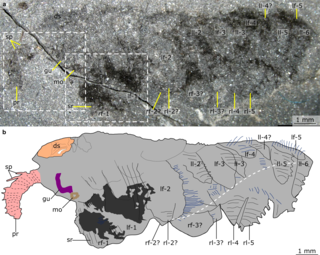
Mieridduryn is a genus of extinct dinocaridid arthropod that lived during the Middle Ordovician of what is now the United Kingdom. This animal was described in 2022 based on a singular fossil found in Castle Bank, a Burgess shale type lagerstätte located in the country of Wales. This animal's taxonomic affinities are somewhat unclear, but there are some hypotheses. One is that this animal represents a new grade of Stem-euarthropods that evolved features similar to the Cambrian aged opabiniids. Another is that if the features seen in Mieridduryn are convergent, and not homologous, to those seen in radiodonts, then this animal represents a late surviving opabiniid.